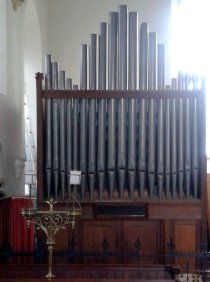The History of St Martin's
A church had been established at Horsley before 1105 when Horsley's independence from Avening parish was confirmed. The living was served by Horsley Priory until a vicarage was ordained in 1380, from which time it has remained a vicarage. The patronage was retained by Bruton Priory until the Dissolution and was subsequently owned by the Crown. Giles Bennett had received a grant of the next presentation after the Dissolution. The Crown continued to appoint through the Lord Chancellor until the early 18th century but by 1750 the bishop of Gloucester was patron and remains so.
The endowment of the vicarage assigned in 1380 comprised 12 marks a year and 4 cart-loads of wood, and the impropriators, Bruton Priory, were required to build a vicarage house. In 1535 the living was worth £7 11s. 4d. yearly and in 1563 the impropriator was charged with paying the incumbent a salary of £8.
Little is known of the medieval vicars who served Horsley after 1380 but Ralph Bennett, instituted in 1425, may have been from a family closely connected with Horsley during the later Middle Ages. Henry Woodhouse, vicar in 1532 and until 1555, was not learned. The living was vacant in 1563 and in 1603 was said to have been so for fifty years; the next recorded institution was that of Samuel Craddock in 1609. During the vacancy the parish was served by a number of assistant curates. In the early 17th century Edward Norris, a Puritan cleric who went to America in 1639, is said to have served at Horsley.
A church recorded at Chavenage in the mid 13th century, for which no later record has been found, presumably served the old village of Ledgemore, north of Chavenage Green; the name Churchyard field and the tradition of a church were attached to a place in that area in the early 19th century.
A church had been built at Horsley by 1105 and the dedication to ST. MARTIN recalls the earliest monastic owners of Horsley. The medieval church, rebuilt except for the tower in 1839, comprised chancel with north and south chapels, aisled nave with south porch, and west tower. The chancel was built or rebuilt c. 1332 by which time the nave and aisles had been built. The tower, of four storeys and incorporating an earlier west doorway, was built during the 15th century at which time the chapels were added. By the end of the 15th century a rood-stair and loft had been inserted in the church.
The church was felt to be inadequate in the early 19th century and subscriptions were raised for building a new church, incorporating the west tower of the old building, to which many of the monuments of the old church were removed. The new church, comprising chancel with north and south vestries, north and south transepts, and broad nave, was built on to the tower to designs by Thomas Rickman and was consecrated in 1839. In 1887 the church was restored and some internal fittings replaced. The bells include two dated 1632, three cast during the 18th century by various members of the Rudhall family, and one, replacing an earlier bell, cast by Mears and Stainbank in 1871.
THE ORGAN
The organ was built by James Ivimey of Southampton and installed in church in 1906.
The organ has two manuals: the Great has 6 speaking stops and the Swell which also has 6 speaking stops, plus 1 pedal stop.
The action of the organ is tracker with pneumatic pedals.
In 2013 the organ and case work had a major overhaul. This involved taking all 678 pipes out cleaning them. The pedal pipes were also repainted.
Most of the leatherwork, for example on wind reservoir, had become stiff and had to be replaced.
The work was under taken by Duncan Bennett who is the local representative for the largest organ builder in the UK the prestigious Harrison and Harrison of Durham.
This organ is tonally ideal for the building and with the good acoustics is quite ample to lead the congregation in worship.
Helen Bowker (organist)

